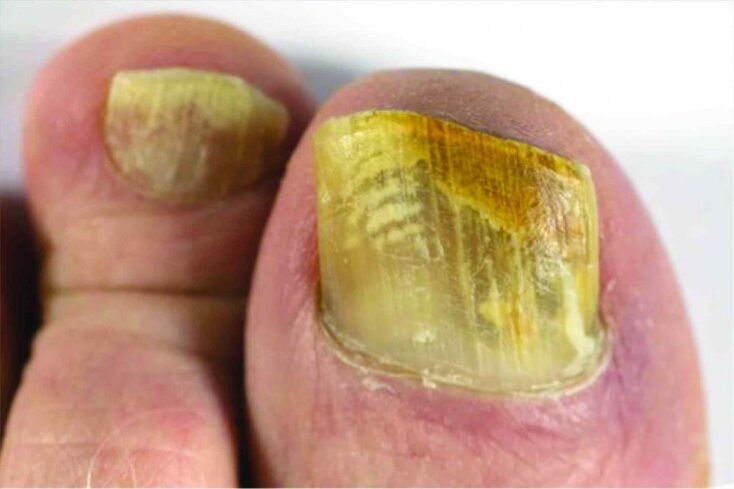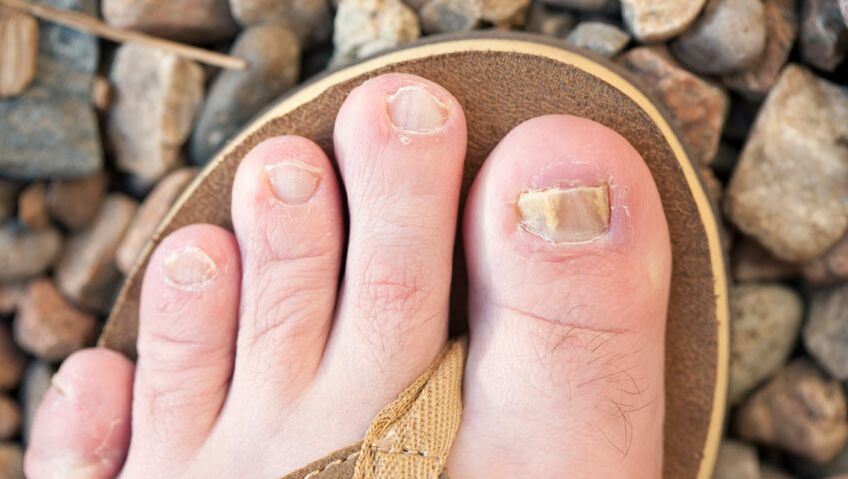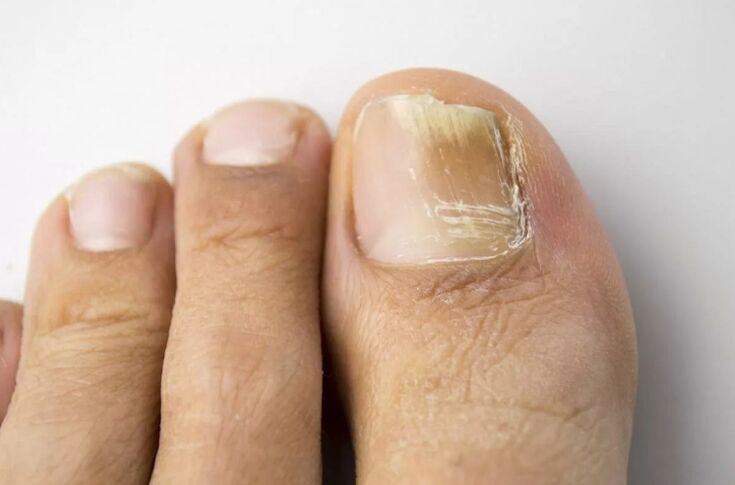Most girls know what a fungal infection of natural pedicure or manicure is and what they can lead to.Not everyone knows what the nail fungus looks like on the legs or hands because the symptoms of injuries depend on the variety of infection.
Signs of nail fungus in the early stages are difficult to distinguish from the lack of normal vitamins of the matrix or weakened immunity, but timely detection of the disease promotes the treatment regimen and the restoration of manicure.

First signs and symptoms of nail fungus
Almost no one knows how to recognize nail fungus, so you should pay attention to the timely diagnosis of the disease.
There are many signs of the disease itself, but they progress when pathogenic bacteria multiply on the surface and deterioration of the normal microflora of the nails.
The nail fungus shows the symptoms quickly and can be visually visually visible.Usually 2-3 days after the infection is coated, the microorganisms quickly multiply and spoil the structure of the nails.
The first signs of the mushroom:
- To change the color of the nail.Standards instead of pink, it becomes yellowish, dark or yellow spots, and stripes on the surface appear.
- Deformation of nail bed.The uneven cavities, hills, the thickness of the nail also changes in the area.Most often, a significant thickening of the main zone occurs, leading to mass formation of disadvantages and gradual destruction of the nails.Manicure deformation often leads to a growing plate to the side rollers.
- Discomfort when pressing it to finger tip.If you press the pillows and feel discomfort, pain, increased tissue density, it is advisable to consult your dermatologist.
- Appearance of diaper rash between the fingers.In this zone, the skin may peel off and there is a risk of separating sensitive epidermis.
- An unpleasant scent.When the infection occurs on the coating, the upper horn layers begin to rot, a change in the nail microflora, which is why an acidic milling scent appears.
Before you determine the fungus on the nails of the feet, always take into account the visual condition of the pedicure.It is recommended to check the suspicious area 2-3 times a day.At this stage, it is recommended to use antifungal methods that prevent further development of the disease.
The main signs of damage to the type of infected fungus depend on.In addition, the defeat often appears on the sensitive skin of the legs or arms, and the symptoms are different:
- Abundant peeling of tissues;
- The skin develops coarse, dense, hard bark;
- The shadow of the epidermis changes - often it becomes yellow;
- Rash, inflammation, irritation appear;
- Pain for direct contact with arms or legs.
Often problems occur at the same time, indicating that sensitive skin is an active form, so you should consult a doctor urgently not to start skin health.

Diagnostic methods
The girl may notice the main symptoms and manifestations of the disease by paying attention to the quality of the arms, legs and natural manicure.
It is essential to get to know the problem with which the state of nails or epidermis has to consult a doctor.Two professionals can identify the presence of the fungus: dermatologist and mycologist.The first deals with general dermatological issues.If you don't know exactly what your nails, contact it.Mycologist is a specialist in infectious and viral diseases of the nails, which analyzes the condition of the manicure in more detail.
When visiting a doctor, the analysis of the nail fungus consists of three stages:
- Question.A visit to the clinic from the patient's theoretical survey begins.To do this, the doctor asks the symptoms of the girl for reasons.The doctor should know what the girl's inconvenience pressed on her fingers, the change in the nails.
- Microscopy.In order to produce the main diagnosis and to prescribe the treatment system, the physician fully examines the affected area with medical gloves.Subsequently, it is concluded from the skin, from the conclusion, from the conclusion after the work of the chemical analyzer.The section includes the examination of analyzes with a microscope to identify the characteristics of pathogenic bacteria.The section allows you to find out the nature of the disease and the degree of development.After microscopy, the doctor usually prescribes the main medicines.
- Microbiological examination.To diagnose the affected area more detailed, the doctor uses the method of involving the microorganisms in the medium, which ensures their rapid spread.One week after the examination of the examination, the doctor may conclude by determining the characteristics of a particular disease.
Doctors do not use a microbiological examination at the seat, but this stage may be needed if the girl has visited the clinic in the presence of an advanced form of disease.
If you do not know which doctor you are looking for, it is advisable to consult with a dermatologist.If complex mushrooms are detected, it redirects you to a mycologist or prescribes a treatment for the disease.

How to determine nail mushrooms at home
In order not to consult a doctor, you can make diagnostics yourself, but be careful - the result is not always accurate in the presence of the initial forms of infection progression.
In addition, visual change does not always indicate the presence of mycosis in the state of manicure, often deformation occurs after mechanical load of fingertips or a decrease in the local immunity of the matrix.
There are two main ways to examine the fungal nail:
- Use of potassium permanganate.The method is safe for a girl and there is no contraindication except for the allergic reaction to the drug.For the procedure, the solution of potassium permanganate is diluted at low concentrations in warm water.The hands or feet are placed in the bath for 10 minutes, at this time the healthy skin and nails are painted dark and the infected remains in the same condition.
- Using iodine.Iod is not suitable for identifying some of the fungi, including onychomycosis, but it shows the presence of lichen, mycoses, and dermatological problems.To perform the analysis, treat the skin and disk with iodine solution and wait for 10-15 minutes until it appears.The healthy surface is ultimately pale color and dark, rich infected.
Keep in mind that manipulations need to be repeated twice in order to make sure it is necessary (may be needed at the early stages of the disease).

How to distinguish your nails mycosis from other diseases?
In the home diagnosis of a natural pedicure, you should take into account all the signs and symptoms of the gradual damage or symptoms of the plate or the deterioration of the quality of the epidermis.
In the early stages, mycosis can often be confused with dermatological diseases, finger damage, or effects of external factors (use of gloveless chemicals, freezing, low quality cosmetics, allergies of the compounds used).
Mycosis has many properties:
- Gradual.The progress of the injury always occurs in stage: first the shadow simply changes, and finally the infection can lead to complete separation of the nail bed;
- An unpleasant scent.The characteristic sour scent is manifested only from the infected area in the presence of a fungus;
- The development of the fungus begins with one finger.Most often, an infection appears in the thumb and turns smoothly to the rest if you do not need to be treated in time;
- Changing the nail shadow, appearance of characteristic spots, stripes of the coating.
When such factors appear, it is important to consult a doctor and take tests to prevent rapid deterioration of the nails, which is quite difficult to repair.
Conclusions
The fungus has characteristic properties that always appear when infection of the plate or epidermis.Note, however, that they can sometimes be confused with other diseases and injuries, so it is recommended to make diagnostics at the clinic or use potassium/iodine permanganate to perform house procedures.
























